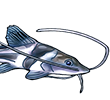After several weeks of working part time on it, my "automatic water change and sump filter" is finally completed.
Here's some rather random pictures of the assembly and final product.
Ingredients:
3 of Wickes 4-gallon header tanks with lids (these hold closer to 7 gallons to the brim).
A bag of bio balls.
A box of ceramic filter media.
1 "sock" (fine filter media to clean the drained water).
A few meters of solvent weld overflow pipe.
An assortment of connections/bends for overflow system.
A length of 32mm waste-pipe (solvent weld).
A couple of 90 degree waste bends.
A Y-connector 32mm waste.
A 45 degree bend 32mm waste.
A decent pump.
A few bits of hose suitable to go on the outside of 21.5mm overflow pipe (3/4" clear PVC hose works well).
A couple of taps.
Silicon sealant if needed (aquarium safe compound).
Solvent weld "glue" (this is the same sort of stuff you use for Airfix models, just a much larger pack and brush - it joins the pieces by dissolving the plastic).
Tools needed:
29mm holesaw (wood/plastic variant).
30mm diamond holesaw.
The final product. The separate 4G tanks are in order from right to left on the picture:
1. Input tank.
2. main filter media.
3. Output tank and heater.
I drilled three header tanks using the 29mm holesaw, to connect them.
I put two tank connectors next to each other to allow good flow of water. One set (at the input side) are high up, and the next set on the diagonal opposite corner at the bottom. This makes the water flow across as much of the filter media that goes in the first and second tanks as possible.
Then I made a hole for the "sock" in the lid of the input tank.
I drilled the glass on the tank and inserted a tank connector, with a suitable set of bends and pipes to get to the overflow drain into the 32mm waste pipe that leads to the sump.
The 32mm waste pipe is then assembled to go from the top aquarium to a Y-connector with a 45 degree bend to make it upright again. The lower aquarium flows into the branch of the Y connector.
Finally, two 90 degree elbow bends lets the water into the sock. [Sock is not in the picture of the complete system, as it got a bit clogged up, and it's in the process of being cleaned].
Why 32mm I hear you ask... Well, we do not want one long overflow pipe to go all the way to the input tank. That would cause a siphon effect of good measure for a tank that is a good meter (3ft) above the sump. A siphon effect would cause the overflow from the aquarium itself to surge on and off, as the siphon drains quicker than the pump will fill, and when the water goes low enough, it then stops draining, until it gets sufficiently high again, etc, etc. So by draining the small pipe into a larger, the siphon is broken (because we let air in). Also, we only need one pipe from the aquarium to the input tank, and there is no problem with the upper tank filling water into the lower aquarium, which could be happening if the two were directly connected - and that could cause the lower aquarium to overflow onto the floor. I do that well enough without having it happening "automatically". ;)
I also made up a strainer from a Eheim intake strainer and a nut for the tank connector - since both are PVC, the solvent weld "glue" works well on these parts.
Now that we have a set of pipes to drain water from the aquriums in the sump, it's time to take water TO the aquariums.
I happened to have a NewJet 1700 pump sitting about doing nothing meaningfull, so I took that and connected it, using some plastic tubing, to a set of overflow pipe with two T's to let me direct water to both aquariums. Each branch of the pipe leads to a tap, and at the "top" I made a "U-turn" to lead back to the input tank. That way I can turn the tap off at one of the aquariums and still let the water flow, and not stress the pump more than it does to run the water all the way upp there.
The taps allow me to adjust the flow into each of the aquariums. The lower aquarium would otherwise recieve most of the water, and not a lot (if any) would get to the top aquarium.
The waste-water output from my RO system is connected to the third tank on the sump, and an overflow pipe takes water away from the same tank, so that the floor doesn't become a swimming pool.
Finally, a heater is introduced to the third tank to keep it all nice and warm.
I did have some intial leaks in a couple of places. The Silicon sealant is a good way to fix those. When joining using solvent weld, do not skimp on the "glue", and don't be tempted to re-adjust the joint once it's started to set - this WILL cause leaks.
Oh, and I had to turn the pump to the lowest setting of flow (supposedly around 600 lph), or the aquariums would overflow.
--
Mats
Building a simple sump system / automatic water changing
- MatsP
- Posts: 21038
- Joined: 06 Oct 2004, 13:58
- My articles: 4
- My images: 28
- My cats species list: 117 (i:33, k:0)
- My aquaria list: 10 (i:8)
- My BLogs: 4 (i:0, p:164)
- Spotted: 187
- Location 1: North of Cambridge
- Location 2: England.




